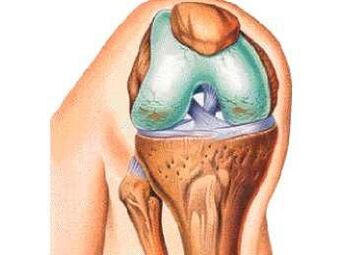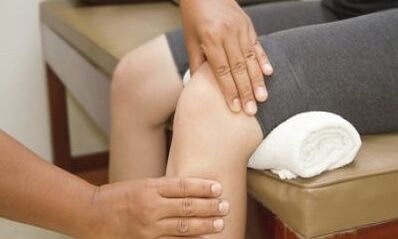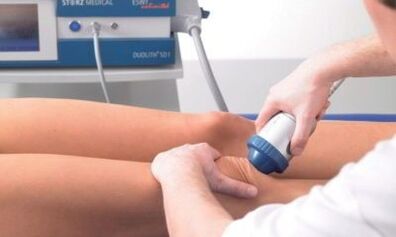Arthrosis or osteoarthrosis of the knee joint is a disease that occurs against the background of dystrophic changes with the subsequent growth of connective tissue.There are many factors that affect the development of the disease, but they all ultimately lead to a disruption of cartilage metabolism.In the medical literature, arthrosis of the knee joint is called gonarthrosis.
According to statistics, gonarthrosis occupies a leading position in the incidence of occurrence among other arthrosis.The disease carries severe discomfort that can develop in pain when walking and at rest.
Knowledge of the early symptoms will help to suspect the development of the pathology and to cure it in the early stages.
Reasons
According to the medical classification, there is primary and secondary gonarthrosis or knee arthrosis.
Knee arthrosis can occur against the background of various diseases or act as their complication.When, due to an unclear history or clinical picture, the exact cause cannot be identified, gonarthrosis is called primary, but if the cause is known, then such arthrosis is called secondary.
Arthrosis develops with age in almost all people, on average this period begins after 45-50 years of life.
The course and pathogenesis of primary and secondary arthrosis are the same and independent of the cause of the occurrence.
The most common causes of arthrosis and osteoarthrosis of the knee joint are:
- traumatic knee damage;
- Deformation of the joint inwards and outside;
- shortening of one lower limb;
- abnormal joint hypermobility;
- Chondroblast dysplasia;
- Cartilage calcinosis;
- Osteomyelitis of the femur and tibia;
- Rheumatoid arthritis or arthritis of any other etiology;
- glucose metabolism;
- Metabolic diseases and hormonal diseases.
Injuries.After receiving the knee injury in the joint cavity, inflammation with a great focus of alaration may develop.Following the disappearance of Pro -receiving agents, the processes of reparation or arthrosis are activated.
Most often, the disease occurs against the background of fracture with rupture of ligaments and damage to the bag and cartilage surface of the joint.

Congenital deformities.Valgus or variant deformation is found very often and without appropriate correction can be complicated by sclerotic changes in the knee.This happens due to the fact that one of the knees falls more than the load than it should be.
Shortening any of the lower limbs.As with deformities, in the pathogenesis of the development of the disease, the improper distribution of knee weight plays the role.
Knee hypermores.In this condition, the wear of the cartilage tissue of the knee joint can occur with subsequent degeneration and degeneration in arthrosis.Hypermorrhis often leads to spontaneous dislocations and sprains of the joint capsule.
Dysplasia with hand.Due to the improper development of the motor surface in the knee joint, pathological growth of the connective tissue occurs.
Calcinosis of the joint.Pathogenesis is based on the deposition of salts in the joint cavity and the formation of a specific precipitate, which causes calcification with subsequent osteoarthritis.
Osteomyelitis.Inflammatory bacterial disease, in which the destruction of bones and joints occurs.First, ankylosis are formed and only then sclerosis.
Arthritis of any etiology.The most dangerous are rheumatoid arthritis, accompanied by autoimmune lesions of the heart and joints.
Diabetes, like metabolic disorders, leads to a disruption of nutrient flow in the joint and germination of cartilage.
Obesity.With high body weight, large loads are on the knees when walking and upright.As a result of constant pressure, blood flow to the knee joints decreases and atrophy develops with dystrophy.
Symptoms

Symptoms of knee arthrosis depend on the stage of the pathological process.On this basis, by analyzing the symptoms and pace of their growth, you can evaluate the scale of changes in cartilage tissue.
Symptoms of knee arthrosis:
- The presence of pathological sounds during movement;
- tenderness after loading or at rest;
- Function reduction;
- edema and enlargement of the joints;
- pathological dislocations, fractures and subluxation;
- Temporary muffle that can occur when bending and expanding the joint.
Clicking and crunching are not immediately noticeable and if they notice, they do not pay due attention.Pathological sounds come across the idea that a pathological process with the deposition of salts or the formation of osteophytes is carried out in the gap of cartilage.
The pain occurs due to the formation of calcina or osteophytes.In the beginning, pain syndrome is not expressed, it later occurs only in the morning and passes after noon, with the progression of the disease can occur at rest.
Reducing joint functions is manifested in the stiffness of movement and reducing their amplitude.Depending on the scene, the restriction of movements can last a certain time and go to rest.
The edema occurs due to inflammation and hypersecretion of the synovial fluid.There are also options when the skin is inflamed on the joints.Such symptoms can be with alena fever or rheumatism.
Dislocations and subluxation arise due to the reason that the process is applied to the bones and knee connections.
Squeezing is a condition during which movement in each axis is completely limited.Such a symptom indicates the neglect of the process and the need for complex treatment.
Arthrosis

Classify osteoarthritis according to the following signs:
- radiological symptoms;
- clinical manifestations;
- Laboratory data.
The most common and convenient classification is radiological, it is simple and understandable even for people without medical education.
Based on X -Ori, four degrees arthrosis in the knee joint are distinguished:
- The reduction of the joint gap is small and there are no osteophytes;
- The difference in the interface is not stretched, but there are signs of small calcins or osteophytes;
- The difference in the interface has a narrowing expression, there are osteophytes, the joint deformation begins;
- Lack of joint gap, bone deformity, ankylosis and dystrophy.
The following stages are distinguished with respect to the clinical picture:
- The mild degree of symptoms are insignificant, appear in the morning and pass 30-60 minutes after waking up;
- The average degree is pronounced symptoms, the feeling of discomfort passes before noon, the swelling is insignificant, it progresses quickly without treatment;
- Strong degree - characterized by constant pain in pain, discomfort at rest, morning stiffness does not pass until dinner, ankylosis, burgis and sinusitis of the knee joint develop.
Laboratory tests are taken, soy and leukocyte indicators are evaluated.It is also necessary to check the presence of a rheumatoid factor.
Diagnostic methods
The diagnosis of knee arthrosis is not complicated, but requires certain skills from the doctor.
Two types of diagnostic measures are distinguished:
- laboratory diagnostics;
- Instrumental diagnostics.
For the correct diagnosis, each method must be taken into account and analyzes the picture as a whole.
Laboratory
If arthrosis is suspected, the doctor present prescribes the following tests:
- General blood and urine test;
- biochemical blood test;
- Determination of antibodies to the rheumatoid factor;
- Determining antibodies to their own cells.
Laboratory data do not provide information on the stage of development of the disease.
Instrumental

The instrumental diagnosis of arthrosis includes the following methods:
- Radiography in two standard projections;
- Minimally invasive arthroscopy;
- UZD examination;
- CT;
- MRI;
- Scintigraphy (according to indications).
Radiation diagnostics are aimed at determining changes in the joint and assessing the condition of the cartilage.
Treatment
Treatment for knee arthrosis is a long process.The duration of treatment is due to the fact that the repair of cartilage tissue is very slow, and in some cases it is completely impossible to restore the joint.
Modern methods of treating arthrosis in the knee joint include comprehensive measures that are aimed at eliminating inflammation, normalizing lifestyle and improving the metabolism of cartilage tissue.
There are such methods of therapy:
- drug therapy;
- Exercise therapy and massage;
- folk medicine;
- Surgical interventions.
The doctor prescribes treatment based on the duration of the disease, the stage of its development and the clinical manifestations.
Medication
Drug therapy is aimed at relieving pain and inflammatory reaction.The following medicines are prescribed for this purpose:
- non -steroidal anti -inflammatory;
- chondroprotectors;
- glucocorticoid;
- Cytostatic.
Knee arthrosis tablets have many side effects, and in the treatment it is necessary to monitor the condition of the gastrointestinal tract and kidneys.
Often, arthrosis drugs are prescribed for a long period, so the least toxic drugs should be chosen.
Exercise
The treatment of arthrosis with the help of exercise is aimed at strengthening the muscles and knee ligaments.With dosage loads in the cartilage of the patient, metabolism improves and regenerative processes are accelerated.
Exercises should be selected individually, taking into account the stage of patient's disease and physical abilities.
Massage
Massage of the knee joint allows you to improve blood flow and relieve discomfort.Proper massage can prevent ankylosis and fake joints.
Folk
Treatment for knee arthrosis at home should not be the main method of combating pathology or can only act in addition to the drug.

House treatment includes:
- weight loss;
- Normalization of labor hygiene and compliance with the regime of the day;
- Fighting inflammation.
The anti -inflammatory effect is possessed by such herbs:
- Thyme tincture and St. John's Cantalon;
- Burdok leaves;
- white cabbage leaves;
- Infusion and decoctions of dandelion and chamomile.
Work
The operation is prescribed with the ineffectiveness of conservative therapy or at the request of the patient.One of the main indications for surgery is the fourth stage of the disease through radiological characteristics.
During the operation, surgeons can completely replace the joint with the endoprosthesis or change one of its parts.

























